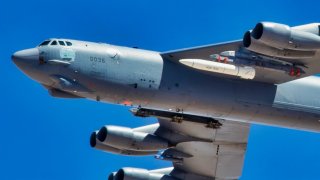The ARRW Hypersonic Missile May Not Be RIP Afterall
The AGM-183 Air-Launched Rapid Response Weapon, or ARRW, is a Lockheed Martin-led conventionally armed (non-nuclear) hypersonic glide weapon program.
In March 2023, Air Force acquisition executive Andrew Hunter told the House Armed Services Committee in no uncertain terms that the program for America’s first hypersonic missile – the AGM-183 ARRW – was effectively dead in the water following a series of high-profile testing failures. However, a January 2024 report published by the Pentagon’s Director of Operational Testing and Evaluation (DOT&E) suggests the rumors of ARRW’s death may have been exaggerated.
With two tests completed since the Air Force declared it had no intention of purchasing the weapon, and a third scheduled for this year, it appears as though ARRW may yet have a path to service after all.
“The Air Force will use the [All Up Round] flight test results to inform their production decision upon conclusion of the current test series,” the DOT&E report reads.
Sandboxx News asked Lockheed Martin if there was still a possibility that ARRW could see active service, though the company did not provide a clear answer in either direction.
“Lockheed Martin continues to partner with the U.S. Air Force to further validate the capabilities of the ARRW system and stands ready to quickly deliver crucial hypersonic-strike capability through our established production line. The recent ARRW flight test demonstrates our confidence in the weapon and its capabilities,” Lockheed Martin said to Sandboxx News via e-mail.
In April of 2023, Sandboxx News published a report highlighting how rushed the AGM-183 ARRW effort truly was, suggesting that it may have been this rush to field the weapon combined with America’s lack of testing infrastructure that ultimately resulted in the program’s failure. The DOT&E’s January report would seem to substantiate those concerns, highlighting the extremely limited testing facilities and equipment available for the effort and, as a result, the inadequate testing regime for verifiable success.
WHAT IS THE AGM-183 ARRW?
The AGM-183 Air-Launched Rapid Response Weapon, or ARRW, is a Lockheed Martin-led conventionally armed (non-nuclear) hypersonic glide weapon program aimed at fielding an air-to-ground missile capable of achieving sustained speeds between Mach 5 and Mach 8 while maneuvering. The weapon has been carried aboard the Air Force’s B-52 Stratofortress throughout testing, but in the long term, was slated to be carried by a variety of aircraft including the B-1B Lancer supersonic bomber, B-21 Raider, and the F-15E Strike Eagle.
Most of the weapon’s specifics remain somewhat murky, but the Congressional Research Service reports that it has an intended range of approximately 1,000 miles. The missile consists of a solid-fuel rocket motor, a protective shroud, and the hypersonic glide vehicle (HGV) itself.
Hypersonic glide vehicles (HGVs) are one of two classes of modern hypersonic weapons, alongside hypersonic cruise missiles (HCMs). HGVs are carried aloft via conventional rocket boosters, but separate at a lower altitude than traditional ballistic missile warheads. From there, the glide vehicle travels – unpowered but at extremely high speeds – down toward its target using control surfaces, chemical thrusters, or some combination of the two for maneuverability. This combination of speed and course changes complicates the math used by today’s advanced missile defense systems, rendering these types of weapons exceedingly difficult to intercept.
A LACK OF HYPERSONIC TESTING INFRASTRUCTURE
The most significant issue facing the ARRW program to date, according to the DOT&E report, is a lack of adequate testing facilities within the United States, forcing all of America’s 70+ hypersonic weapon and aircraft programs currently in development to compete for very limited range time. ARRW testing, for instance, has largely been conducted over open ocean that provides the ranges required for missile flight testing, but minimizes the data that can be gathered about terminal flight characteristics or even accuracy.
Other tests conducted over ground ranges with appropriate sensors in place were also hampered by sensor failures on the range itself, once more, limiting the amount of data that could be collected about the missile’s performance.
WHAT’S NEXT FOR ARRW?
With one more test already on the books for later this year and at least two previous tests of complete ARRW missile systems, for which we know very little, it would seem the Air Force hasn’t completely given up on the ARRW concept. Last March, the Air Force indicated its intentions to focus more on the scramjet-powered Hypersonic Attack Cruise Missile, or HACM – which may be the world’s first such weapon to enter service in the coming years. However, if ARRW ultimately manages to outperform expectations in this upcoming test, we may yet see the Air Force choose to purchase a limited number of these advanced weapons for use in very specific circumstances.
But even if not, continued testing of ARRW could provide essential data for other hypersonic weapons and even aircraft programs also underway. Because flying at hypersonic speeds directly affects the chemical makeup of the air being passed through, tons of data needs to be collected about hypersonic flight to create accurate simulations for later developmental efforts.
So, while ARRW may not be dead after all – even if it is, some aspects of this effort are sure to live on for years to come.
About the Author
Alex Hollings is a writer, dad, and Marine veteran.
This article was first published by Sandboxx News.


